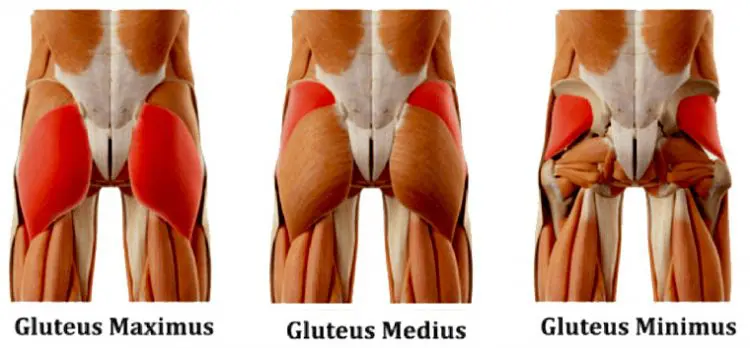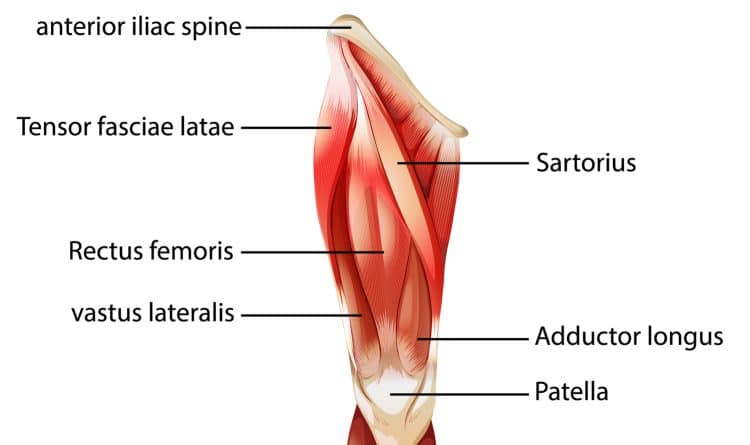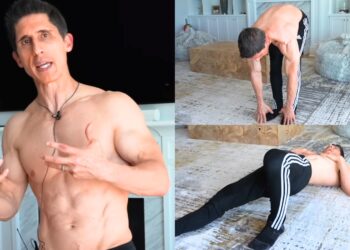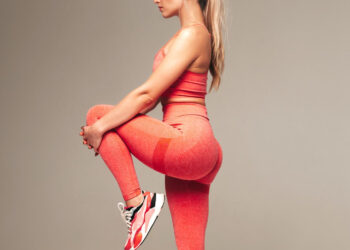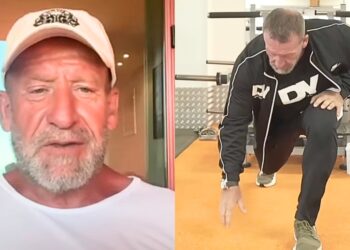Everyone needs strong glutes. The glutes are heavily involved in almost every activity you perform, from walking to running to lifting to jumping. They make up a large part of your posterior chain, and, to be blunt, well-developed glutes look pretty good, too.
For these reasons, smart lifters the world over include plenty of glute-building and strengthening exercises in their workouts.
Some of the best glute exercises include:
- Squats
- Deadlifts
- Lunges
- High step-ups
- Banded side steps
- Cable pull-throughs
- Cable hip extensions
- Cable hip abductions
- Hip thrusts
- Glute bridges
However, while your glutes can never be too strong, they can become too tight and short. This is especially true if you train your glutes hard, heavy, and often but don’t stretch them enough.
Glute tightness can have a negative impact on your hips, lower back, and even your knees.
So, in this article, we reveal the 11 best glute stretches for flexible, mobile hips.
Level Up Your Fitness: Join our 💪 strong community in Fitness Volt Newsletter. Get daily inspiration, expert-backed workouts, nutrition tips, the latest in strength sports, and the support you need to reach your goals. Subscribe for free!
Glute Anatomy Basics
When it comes to the glutes, most people automatically think about the gluteus maximus. After all, this is the largest and most prominent glute muscle. However, the gluteus maximus is only one of the muscles that make up your gluteal complex, and the other muscles are every bit as important.
The main muscles of the gluteal complex are:
Gluteus maximus
You are probably familiar with this large, powerful muscle, but here’s a quick refresher course on its structure and function.
The gluteus maximus is the most significant muscle in the human body. It’s located on the back and side of your hips and is often known as the butt. Sometimes called the glutes for short, this muscle has several functions:
- Hip extension
- Hip lateral (external) rotation
- Hip abduction (superior or upper portion)
- Hip adduction (inferior or lower portion)
Gluteus minimus
The Gluteus minimus is a small triangle-shaped muscle located toward the back of your hip. It works alongside the gluteus maximus, and its functions are:
- Hip abduction (movement away from the midline of the body)
- Hip medial (internal) rotation
- Pelvis stabilization
Gluteus medius
The gluteus medius is located above and underneath the gluteus maximus near the upper edge of the pelvis. It works alongside the gluteus maximus but also has some additional functions:
- Hip abduction
- Hip medial rotation
- Pelvis stabilization
Piriformis
Don’t let the lack of a “glute” prefix fool you; the piriformis is most definitely part of the gluteal complex.
Piriformis is shaped like a pyramid and lies parallel to the rear edge of the gluteus medius. It is flat and runs from the front of the sacrum, part of the pelvis, through the greater sciatic notch and attaches to the head of the femur. It works with the glutes, and its functions are:
- Lateral (external) rotation of the hip when standing.
- Abduction of the hip when it is flexed.
- Tilting the pelvis laterally.
- Tilting the pelvis posteriorly.
- Stabilization of the hips and pelvis.
Read more about stretching the piriformis muscle in this guide.
Tensor fascia latae
Meaning band of white tissue, the TFL is part of the glute complex despite not having the word gluteus in its name. It’s a biaxial muscle which means it crosses two joints – the hip and the knee. As part of the glute group, TFL is involved in the following movements:
- Hip medial rotation
- Hip abduction
- Pelvis stabilization
While it IS possible to emphasize or isolate certain glute muscles, more often than not, they work together as they have several shared functions. These muscles need to be strong, but they also need to be flexible, which is where the best glute stretches come in!
Why You Need to Stretch Your Glutes
Your glutes are part of a group of muscles called the posterior chain. Other muscles within this group include the hamstrings and spinal erectors. In simple terms, the posterior chain is the collective name for the muscles on the back of your body that work together to extend your hips and spine.
If your glutes become tight, the other muscles need to stretch and flex to take on the work that the glutes are less able to do. This can cause problems up and down the kinetic chain.
For example, if your glutes are tight, movements that involve leaning forward could put more stress on your lower back. Similarly, if the lateral glute muscles become tense, your knees might bow outward, placing unnecessary pressure on the hip and knee joints, and even affecting your ankles and feet.
Common problems caused by glute tightness include:
- Tight hamstrings
- Pelvic instability
- Lower back pain
- Knee pain
- Iliotibial band (ITB) pain
- Hip pain, soreness, and tightness
- Hip instability
- Gluteal pain
- Gait issues, such as knees traveling outward (knee varus) and over supination
Because the glutes are so powerful and are involved in so many different movements, too much glute muscle tension can have a significant impact on almost every action you perform.
So, while glute strength IS essential, these muscles also need stretching to prevent tightness.
What causes glute tightness?
The main reasons that the glutes become tight are overuse or underuse. Training your glutes too frequently, especially using a repetitive or shortened range of motion, will cause them to shorten. This is called adaptive shortening. Overuse of booty bands can cause the glutes to tighten up.
In contrast, being sedentary and not using your glutes enough will also cause them to tighten up.
So, if you train your glutes, you also need to stretch them, and if you DON’T train your glutes, you also need to stretch them. So, stretch your darn glutes, y’all!
The 11 Best Glute Stretches
Got tight glutes? Or just want to stop them from tightening up in the future? Here are 11 of the best glute stretches for flexible, more mobile hips.
- Seated knee-to-chest glute stretch
- Supine knee-to-chest glute stretch
- Seated figure four glute stretch
- Supine figure four glute stretch
- Knee hug glute stretch
- Supine knee to-to-opposite chest glute stretch
- Pigeon pose
- Seated leg cradle glute stretch
- Elevated lunge glute stretch
- Assisted standing figure four glute stretch
- Foam rolling the glutes
1. Seated knee-to-chest glute stretch
This simple exercise is ideal for breaking up long periods of sitting and easing glute tension without having to move away from your desk. While you won’t get a deep glute stretch from this position, it should be enough to maintain glute flexibility. It’s also a valuable exercise for destressing your lower back.
Steps:
- Sit up straight with your feet planted firmly on the floor. Engage your core.
- Lift one leg and wrap your arms around your knee.
- Gently pull your knee toward your chest. Do not lean forward. Instead, bring your leg up to meet your body.
- Hold for 30 to 60 seconds, and then swap legs.
2. Supine knee-to-chest glute stretch
Pulling your knee into your chest while lying on your back means you can move your hip through a larger range of motion, getting a deeper stretch in your glutes. This is a good exercise if you want to stretch for longer or just relax as you work on your glute flexibility.
Level Up Your Fitness: Join our 💪 strong community in Fitness Volt Newsletter. Get daily inspiration, expert-backed workouts, nutrition tips, the latest in strength sports, and the support you need to reach your goals. Subscribe for free!
Steps:
- Lie on your back with your legs straight and arms by your sides. Engage your core.
- Bend and lift one leg toward your chest. Wrap your arms around your knee and pull your leg closer to your body. Do not sit up to meet it. Instead, pull your leg closer toward you to get a deeper stretch.
- Hold for 30 to 60 seconds, and then swap legs.
3. Seated figure four glute stretch
This exercise targets all the gluteal muscles, including the piriformis. A tight piriformis can put pressure on the sciatic nerve, causing pain to radiate down your leg. Tight piriformis muscles are very common, especially among runners. This exercise is arguably one of the most convenient ways to target this often-troublesome muscle.
Steps:
- Sit on a sturdy chair so your knees are bent to around 90 degrees. Adopt a good posture so your torso is upright.
- Cross your left ankle over your right knee.
- Gently press your left knee down to open your hip.
- Without rounding your lower back, lean forward until you feel a stretch in your gluteal region.
- Hold for 30-60 seconds, and then relax.
- Swap legs and repeat on the other side.
4. Supine figure four glute stretch
Like the seated figure four stretch, this exercise hits all your gluteal muscles, including that pesky piriformis. This is quite an intense stretch and may be too challenging if you have very tight glutes. However, if you practice and persevere, this is arguably one of the best total glute stretches you can do.
Steps:
- Lie on the floor with your legs bent and feet flat.
- Cross your right ankle over your left knee.
- Lift your legs and hold the back of your left knee. Gently pull it toward you. Make sure you keep your shoulders and upper back on the floor.
- You should feel a deep stretch in the right hip and glute. The closer you pull your leg toward you, the more intense the stretch will be.
- Hold for 30-60 seconds, and then repeat on the other side.
5. Knee hug glute stretch
This gentle stretch is good for your glutes and will also help release tension from your lower back. It’s very relaxing and something you can do anytime you need to reduce your stress levels. This is an excellent exercise for anyone whose glutes are so tight that they cannot perform more demanding exercises.
Steps:
- Lie on your back with your legs straight and arms by your sides. Engage your core.
- Bend your legs and wrap your arms around your knees.
- Keeping your head and shoulders on the floor, pull your knees toward your chest.
- Hold for 30 to 60 seconds, and then slowly lower your feet back to the floor.
6. Supine knee to-to-opposite chest glute stretch
While the standard knee-to-chest exercise provides a nice stretch for your glutes, it doesn’t do much for the hip rotators, i.e., the piriformis, gluteus medius, and gluteus minimus. While this is still a relatively gentle stretch, it has the benefit of hitting all those additional glute muscles.
Steps:
- Lie on your back with your legs straight and arms by your sides.
- Bend one leg and hold the outside of your knee with the opposite hand.
- Gently pull your knee in and across toward the opposite side of your chest. Do not lift your upper body up to meet your knee. Instead, remain lying flat on the floor.
- Hold for 30-60 seconds and then release.
- Switch sides and repeat.
7. Pigeon pose
Pigeon pose is a classic yoga exercise that hits all parts of the gluteal complex. This is quite an advanced exercise, so only attempt it if you have already developed a reasonable level of glute flexibility and are feeling warm and supple. Ease into this stretch, going deeper only as you feel your muscles begin to relax.
Steps:
- Kneel on the floor on all fours with your shoulders over your hands and your hips over your knees. Engage your core.
- Extend one leg out behind you.
- Sit back and roll your bent knee outward. Your front foot should be below your opposite hip.
- Ease your body down toward the floor as far as comfortable, using your weight to stretch your hip.
- Rest your forearms on the floor in front of you. Alternatively, just keep your arms straight, which should feel somewhat easier.
- Hold for 30-60 seconds, and then release.
- Switch sides and repeat.
8. Seated leg cradle glute stretch
The seated leg cradle hits all your glutes simultaneously, including the piriformis. Because this exercise is quite dynamic, it’s a good stretch for warming up, e.g., before running or squats. After this exercise, your hips and glutes should feel pleasantly loose and mobile.
Steps:
- Sit on the floor with your legs straight and your torso upright.
- Bend one leg and pull your knee toward your chest.
- Support your foot and rotate your bent knee outward, so your shin is parallel to the ground.
- Hold for 30-60 seconds and then release.
- Switch sides and repeat.
- You can also do this exercise while lying on your back or sitting in a chair.
9. Elevated lunge glute stretch
Lunges are generally viewed as glute strengthening or hip flexor stretching exercises. However, if you elevate your front foot and hold the lunge position statically, you’ll also get a great stretch in the glutes of your front leg. Not convinced? Try it for yourself!
Steps:
- Stand a few feet away from a sturdy raised platform, such as an exercise bench or aerobic step.
- Place one foot on the platform, so you’re in an extended stance.
- Ease your weight forward and lower your hips down toward the floor. The deeper you go, the more you’ll feel this in your glutes.
- Bend your back knee to take the stress off your hip flexor and focus more on your glutes. You can also lean forward to lengthen your glutes a little more.
- Hold for 30 to 60 seconds, and then ease out of the stretch.
- Swap legs and repeat.
10. Assisted standing figure four glute stretch
Many people find the seated and supine figure four glute stretches difficult or uncomfortable. Just reaching the bent leg to pull it in is a struggle! This exercise is just as effective but far more accessible, so it’s a good choice if your hip mobility is not quite as good as it needs to be to pull off the standard figure four stretches.
Steps:
- Stand facing a hip-high platform, e.g., countertop, massage couch, or a couple of stacked plyo boxes. The higher the platform, the more intense this exercise becomes.
- Bend one leg and place the outside of your foot on the top of your platform. Let your knee rotate outward. Your foot should be in front of the opposite hip. Hold your foot and rest your other hand on your knee.
- Lean forward to increase the stretch while keeping your knee bent and out to the side.
- Hold for 30-60 seconds and then release.
- Switch sides and repeat.
11. Foam rolling the glutes
Foam rolling is a great way to release tension from your muscles and improve circulation. It’s like getting a GREAT massage. In addition, foam rolling helps free up the fascia, which is the fibrous tissue that separates, links, and surrounds all the muscles in your body. Facia can become “gummed up,” reducing your range of motion and circulation.
Steps:
- Sit on your foam roller with your legs bent and feet flat on the floor. Cross your right ankle over your left knee and place your right hand behind you for balance.
- Shift your weight over onto the right side of your glutes.
- Roll up and down your glutes seeking out any areas of localized tension, aka hotspots. Stay on these hotspots until they melt away.
- Make sure you roll the entirety of your glutes, including the sides, where gluteus minimus and medius are located here.
- Continue for 1-2 minutes, and then relax and swap sides.
- You can also massage your glutes using a tennis or lacrosse ball. This allows you to concentrate more pressure in a smaller area for a more localized effect.
Glute Stretches FAQs
Do you have a question about stretching your glutes? That’s okay because we’ve got the answers!
1. How often should I stretch my glutes?
The tighter your glutes are, the more work it will take to fix them and the more often you need to stretch. So, if your glutes don’t feel tight at all, you can maintain their flexibility by stretching just two to three times a week.
But, if your glutes are really tight, you may need to stretch them several times per day to see any noticeable improvements in your flexibility. That’s especially true if you concurrently perform activities that cause your glutes to tighten up, such as lots of squats and deadlifts, cycling, or running.
It can also be helpful to stretch your glutes more frequently if you spend a lot of time sitting, i.e., at a desk or driving.
2. What is the best way to stretch my glutes?
Improper stretching can be ineffective and even dangerous, so make sure you pay attention to how you perform the exercises in this article.
Choose your exercise and then get into position, so you feel a mild stretch in the target muscles, i.e., the glutes. Hold this position for 10-15 seconds. You should feel the muscle begin to relax.
Move into a slightly more stretched position and then hold again for another 10-15 seconds.
Repeat this sequence a couple more times until you feel your muscles have been stretched enough. Ease out of the stretch and then repeat on the other side.
Back off the stretch if you feel:
- Pain – especially burning – in the target muscle.
- The muscle starts to shake.
- Pain radiating down your legs.
All of these signs suggest that you are stretching too far and too aggressively. Ease off to avoid injury.
3. Do I really need to stretch my glutes?
Unfortunately, this is a question only you can answer. The best way to determine if your glutes are tight is to try stretching them and see how you feel. If you cannot perform any of the stretches, you probably need to stretch your glutes more. But, if you do the stretches with ease and feel very little tension in your glutes, they may well be flexible enough.
If in doubt, do a couple of stretches per week to err on the side of caution.
4. How can I stop my glutes from tightening up?
Muscles shorten up with a lack of use. Also, adopting and maintaining a shortened position will make your muscles tighten up. This is especially true if you spend a lot of time sitting.
The best way to prevent all this tightness is to sit less and move more. Try to take all your joints through a large range of motion as often as possible.
One way to do this is to set an alarm to sound every hour. When it goes off, get up and move for five minutes. Shrug and roll your shoulders, rotate your neck, flex your hips, rotate your spine, bend your knees, and circle your ankles. This will help offset the effects of prolonged sitting.
If you notice that any muscles feel tight, stretch them for a few seconds before getting back to work.
5. I find some of these glute stretches painful. Should I still do them?
While some mild discomfort should be expected when stretching, it should not be painful. If any of these exercises hurt, ease back a bit and don’t stretch so deeply. If that doesn’t stop the pain, try switching to a different exercise.
Pain radiating down your legs or a burning sensation through the muscles suggests you are over-stretching and could be causing more harm than good. Back off, don’t do too much too soon, be patient, and pick the exercises that best suit your body type.
Finally, never force a stretch, as doing so can cause serious injuries.
Related:
- Piriformis Stretches to Help Eliminate Butt and Hip Pain
- Stretches for Flexible, More Mobile Hips
- Frog Stretch Guide: How To, Benefits, Muscles Worked, and Variations
- Tensor Fasciae Latae Stretches, Exercises, Functions, and Tests
- Gastrocnemius Stretches for Tight Calves
- Quadriceps Stretches for Healthier, More Mobile Knees
- Hamstring Stretches for a Healthier Lower Back and Knees
Wrapping Up
When it comes to stretching, many people forget all about their glutes. Instead, they focus on more common areas of tightness, such as the hamstrings, pecs, and shoulders. However, the glutes are one of the hardest working muscles in the body, and they, too, need stretching.
Use the exercise in this article to maintain or improve your glute flexibility. Your hips and lower back will function better if you do, and your lower body workouts will be much more productive.
So, tight glutes? Just say NO!

